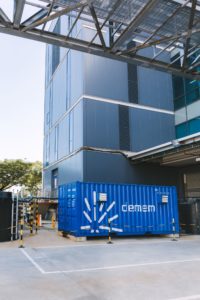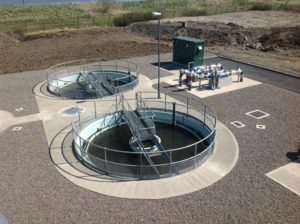AERZEN Makes Wastewater Treatment Plants fit for the Future

By using modern and efficient Delta Hybrid rotary lobe compressors in combination with the new aeration system, the energy consumption in the activation of the Liebenwalde wastewater treatment plant near Berlin could be significantly reduced. (Image source: Aerzener Maschinenfabrik GmbH)
Thanks to extensive energy optimisation, co-financed with state funds, the Liebenwalde wastewater treatment plant, north of Berlin, was able to reduce its energy consumption by half and its CO2 emissions by 60 percent - and thus not only saves costs of around 60,000 euros annually, but also makes an important contribution to climate protection. A central role is played by the modern and efficient rotary lobe compressors from AERZEN.
Wastewater treatment plants are usually the largest energy consumers in municipalities. Nevertheless, the focus to date has been almost exclusively on security of supply and purification performance (compliance with monitoring values). Efficiency was not an issue for a long time. At the same time, municipal wastewater treatment usually consumes 30 to 40 percent more electricity than necessary. The savings potential is therefore enormous.
However, in view of rising energy prices, increased cost pressure and the targeted CO2 reduction as a result of the Paris Agreement (65 percent less CO2 emissions by 2030 compared to 1990 levels), energy and resource efficiency is increasingly becoming a decisive factor for wastewater treatment plant operators - and energy optimisation is thus a key priority.
Optimising ventilation is the key to more energy efficiency
The Trink- und Abwasserzweckverband (TAV, Drinking water and wastewater association) Liebenwalde has recognised the signs of the times and fundamentally modernised its wastewater treatment plant, which originally went into operation in 1995. The focus was on optimising the aeration system in the aeration tank, because the biological treatment stage accounts for 60 to 80 percent of the total energy demand in wastewater treatment. By converting to new, efficient Delta Hybrid rotary lobe compressors and replacing the aeration system, it was possible to optimise the oxygen supply and significantly reduce energy consumption in the aeration. The installation of new piping and the use of an additional return sludge screen in the return structure also contributed to this. This removes solids that would otherwise settle on the aerators in the aeration tank and reduce efficiency. “We deliberately chose assemblies from AERZEN again,” says Wolfhard Raasch, Technical Manager of the Liebenwalde wastewater treatment plant. He explains why: “AERZEN blowers had already been used when the plant was built. Today, a quarter of a century later, some of them are still in operation and running like clockwork. The cooperation also works wonderfully. We are really very satisfied.”
Rotary lobe compressors: the best of both worlds
At the Liebenwalde wastewater treatment plant, two Delta Hybrid D 62S rotary lobe compressors with an intake volume of 41.7 m3/min and a pressure difference of 480 mbar provide the compressed air supply in the aeration tank. Rotary lobe compressors or screw blowers are among the most innovative solutions in compressor technology. They combine the advantages of blower and compressor technology in one system. The decisive factor for the Delta Hybrid application in Brandenburg was the possibility of outdoor installation. “The assemblies should be placed directly at the basin without housing,” says AERZEN sales engineer Christian Meyer.
Specialists for outside using
The Delta Hybrid are very well suited for outdoor use. Thanks to their galvanised steel construction, powder coating, as well as a sealed acoustic hood design with a sophisticated air ducting inside, they are optimally designed for wind and weather and also cope effortlessly with the H2S load typical of wastewater treatment plants. An oil sump was also installed, so that the environment is not polluted in the event of an accident or when changing the oil. Outdoor installation directly at the basin offers two main advantages: firstly, the connecting pipework can be extremely short, which reduces energy losses to a minimum. The second point concerns the temperature of the intake air. From a thermodynamic point of view, this should be as low as possible. However, a housing would have the opposite effect: the air around the assemblies would heat up, with the result that it can no longer be optimally compressed.
“As a rule of thumb, you can say that a temperature reduction of 3 °C leads to an energy saving of 1 percent,” Christian Meyer makes clear. “For this reason, by the way, our blowers always suck in the air on the “cold” side of the assembly and not on the side of the pressure connection, as there is a lot of radiated heat there.”
Financing through subsidies
AERZEN also established contact between the Liebenwalde wastewater treatment plant and the industry platform e.qua. e.qua is a network of municipal companies in the water industry with a focus on energy efficiency, energy (recovery) and resource management and has made a name for itself in particular as a funding scout. “Many wastewater treatment plant operators don’t even know that they can apply for state subsidies for energy optimisation Thanks to the outdoor installation of the AERZEN blowers directly at the basin, the connecting pipework can be extremely short, which reduces energy losses to a minimum. - up to 80 percent. Even the preparation of the potential study, which is the basis for every subsidy application, is subsidised by 50 percent,” emphasises e.qua Managing Director Andreas Koschorreck. For the Liebenwalde wastewater treatment plant, e.qua took over the entire funding management. It was the cooperation and collaboration between AERZEN and e.qua which enabled the Liebenwalde wastewater treatment plant to make the investments in climate-friendly wastewater treatment in the first place.
The optimisation of the aeration system in the aeration tank was not the only major energy project. The installation of a 100 kWp ground-mounted photovoltaic system with battery storage and the construction of a sewage sludge humification plant were also implemented. With the PV system, one third of the wastewater treatment plant’s electricity consumption is covered by renewable energy sources. The two-hectare sewage sludge humification plant also offers significant advantages in terms of climate protection compared to the old mechanical thickening plant. The higher dry matter content of 40 percent (previously: 6 percent) reduces the amount of transport required for agricultural use by a total of 90 percent. In addition, chemicals are no longer needed, and electricity consumption is very low.
From energy guzzler to climate leader
For the Liebenwalde wastewater treatment plant, the investments in increasing energy efficiency and the use of renewable energies have more than paid off. For example, the plant’s energy consumption has been reduced from 40 kWh to 18 kWh population equivalents (PE) per year. A look at the CO2 emissions shows a saving of 62 percent. Overall, cost savings of 61,600 euros per year can be achieved. “The modernisation was exactly the right step.
With the energy optimisation, we have made a real quantum leap and are optimally positioned for the future - thanks to the active support from AERZEN,” says Wolfhard Raasch. He already has another goal in mind: “We want to become independent of external electricity suppliers and therefore plan to further expand photovoltaics. The future is called energy self-sufficiency.”
Source: Aerzener Maschinenfabrik GmbH







